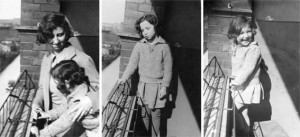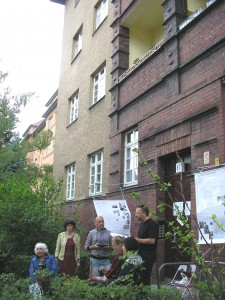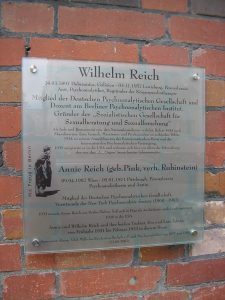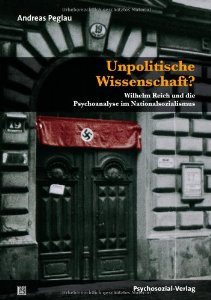by Andreas Peglau[1]
*
In November 1930, Reich moved from Vienna to Berlin. The German psychoanalysts, he writes about this, „were far more progressive in social questions than the Viennese. The youth breathed more freely.“ He received professional recognition here as well, became a teaching analyst again, and also a member of the Deutsche Psychoanalytische Gesellschaft (DPG). In particular, the circle of „left-wing“ analysts around Otto Fenichel, which also included Edith Jacobssohn and – for a time – Erich Fromm, enabled him to exchange views among largely like-minded people.
Reich’s reputation as a potential troublemaker, which endangered the maintenance of the desired psychoanalytic image, had, of course, preceded him to Berlin.
Conflicts were programmed, especially with Freud confidant Max Eitingon, who at this time not only headed the Berlin Institute and the DPG, but was also president of the International Psychoanalytic Association (IPA), a major donor, and a shareholder in the International Psychoanalytic Publishing House. Reich reports Eitingon’s greeting:
„I had full freedom in the [Communist – A.P.] Party to give courses on psychoanalytic psychology. In contrast, I had been requested by the chairman of the Berlin Psychoanalytic Association [sic] as soon as I arrived in Berlin not to bring sociological topics to the professional organization.“ (Reich 1995, p. 202)
This request was made even more questionable by the fact that – a few weeks before Reich arrived in Germany – there had been a „political landslide“ in Germany: in the Reichstag elections of September 14, 1930, the NSDAP had become the second strongest party. The need to reflect on „sociological“, i.e. social, processes had thus increased immensely.
Reich quickly found opportunities to work outside of the psychoanalytic institutions, especially through his probably immediate entry into the KPD (see, among others, articles about the Marxist Workers‘ School MASCH and about the Unified Associations for Proletarian Sexual Reform and Maternity Protection). But he also continued to work on therapy methodology.
At first Reich had lived on Schwäbische Strasse in Berlin-Schöneberg. When his wife and fellow analyst Annie came to Germany in 1931 with their daughters Lore (b. 1928) and Eva (b. 1924), the family rented an apartment in Berlin-Wilmersdorf, at Schlangenbader Str. 87.

Annie Reich, Eva and Lore (from left to right), photographed by their father Wilhelm on the balcony (with sincere thanks to Lore Reich Rubin).
What has hardly been appreciated so far: It was precisely here that Reich made the transition from character analysis to body psychotherapy. More accurately, however, it should read: to psychobody therapy. For in Berlin, the focus of Reich’s treatments was still clearly on the soul.
As early as 1929, he had begun „to understand that the initial conflict of mental illness (the unresolved contradiction of desire striving and moral failure), anchors itself physiologically structurally in the form of muscular disturbance“ (Reich 1987, p. 194). He devoted increasing attention to this in his treatment work in Berlin.
As was customary with many analysts, this took place in his living quarters. Daughter Eva Reich reported, „All my childhood I had to disappear when the patients took turns. They were not supposed to know that there was a whole family living there.“ And Lore Reich Rubin added in a conversation with me: „My parents had separate bedrooms. In the morning, the beds disappeared and the bedrooms became treatment rooms.“ She also recalled that these rooms, or the apartment belonging to them, were on the 2nd or 3rd floor of the house.
So if the „birth“ of body psychotherapy occurred here, how did it proceed?
Reich’s book Charakteranalyse, published in 1933, illustrates this process. In it, he describes, among other things, the treatment of a severely sexually disturbed young man who was marked by ideas of greatness and strongly idealized his father:
„It was not easy at first to get the patient to reactivate the defiant acting out of childhood … Surely a distinguished person … cannot do such things…. (I) first tried interpretation, but met with complete ignorance of my efforts. Now I began to imitate the patient …“
Unsettled by this, apparently also annoyed, the patient reacted
„with an involuntary stamping. I took the opportunity and asked him to let himself go completely. At first he did not understand how one could invite him to such a thing, but finally he began with more and more courage to throw himself back and forth on the sofa in order to then move on to affective affective, defiant screaming and roaring out unarticulated, animal-like sounds. Such a fit became particularly strong when I once told him that his defense of his father was only a masking of his excessive hatred against him.
I also did not hesitate to grant this hatred some rational justification. His actions now began to take on an uncanny character. He roared so much that the people in the house began to become anxious. This could not disturb us, because we knew that only in this way could he relive his childlike neurosis fully, affectively, not only in terms of memory“. (ibid., p. 299)
Reich then reports how in the course of the following hours it could be worked out that the patient wanted to provoke the therapist with this behavior to become as angry and strict as the patient’s father had once been. Reich thus spent a lot of time trying to place this kicking and screaming in life-historical contexts and in the therapeutic relationship. In other words, he worked very much „analytically“ with this material.
Thus, in my view, he did not leave psychoanalysis here either – but enriched it: by the systematic therapeutic inclusion of body, emotion, emotional expression.[2]

Left: Schlangenbader Straße 87, more than seven decades later. This picture was taken on 23.6.2007 at the dedication of a memorial plaque for Wilhelm and Annie Reich. Seated: Lore Rubin-Reich (left), far right her daughter Erica. Standing: Regine Lockot, Christian Find, Andreas Peglau. (Photo: Gudrun Peters)
Attaching importance to this at the same time enabled Reich to better understand current social changes. From now on, he was confronted with an unprecedented intensity with the acquired destructiveness of his patients, which they normally hid behind a conformist, „nice“, polite mask. If he did not meet their neurotic expectations, but instead supported them in showing the feelings that rose up as a result, their hatred of oppressive authorities, which had been pent up since childhood, often broke out. And Reich recognized this hatred – rationalized and channeled through party ideologies and organizations – on the streets of Berlin, where the bloody clashes between „left“ and „right“ had long since regularly claimed lives. This was to inform his Massenpsychologie des Faschismus.
Sigmund Freud, however, must have deeply disliked Reich’s therapeutic approach, since it had become Freud’s ideal to suppress his outbursts of rage in a „manly controlled“ manner or even to basically achieve „victory over the passions,“ which he considered to be rather culture-destroying and antisocial anyway. He therefore counted among the goals of psychoanalytic treatment learning to master drive-controlled actions (Gay 2006, S. 358, Freud 1923a, S. 227f.). He had found the right setting for this: Lying on a couch, real outbursts of rage can hardly be experienced.
With such premises, how could Freud have made friends with Reich’s emotionally agitating body psychotherapy, which assumed the existence of prosocial human drives?
How far Reich had already come in Berlin on the path that was to lead him to „vegetotherapy“ in Scandinavia and to „orgone therapy“ in the USA is also shown by the lecture he was to give in 1934 at the Lucerne congress at which his expulsion from the International Psychoanalytic Association became official. Under the heading „Further Problems and Some Consequences of Character Analysis,“ he presented the current state of his therapeutic skills.
In 1935 he published a supplemented version of the lecture as a pamphlet under the title „Psychischer Kontakt und vegetative Strömung“ (Psychic Contact and Vegetative Flow). He also included this text in the 1945 English edition of Charakteranalyse (Reich 1999, S. 389–468). In this new version, expanded by several chapters, it can be read on the one hand how Reich more and more consistently included the body and, after 1940, also the life – or „orgon“ – energy in the healing.
On the other hand, it becomes clear that in the process, the examination of the patient’s life story, the relationship between patient and therapist, and ultimately the psyche as a whole increasingly slipped into the background. Based on the assumption of a superordinate energy, he believed that getting this energy to flow would also fix everything else. The treatment should now involve as little talking as possible, since the „language of words regularly functions as a defense“ and the „“body language expression“ is more relevant anyway.
With Reich’s very active, determining approach, e.g. the repeated „inducing“ of deeper breathing, there was hardly any room left for working through what psychoanalysts call transference and projection. If „very intense hate impulses“ occurred, however, he continued to „clarify“ them with „character-analytic methods in the psychological field“ (Reich 1999a, S. 476; 531, 599).
In my opinion this means: Reich’s further progress was bought with a great, too great loss. Body psychotherapy became body therapy.
However, this very fact underlines once again the great importance of Reich’s Berlin creative period.
It seems to me that neither before nor after did he devote his attention to the interplay of body AND soul as intensively as in Schlangenbader Straße.
***
The forwarding and distribution of the above text for non-commercial purposes is expressly desired.
Here you can download the above text as pdf
Notes
[1] Based on passages from „Unpolitische Wissenschaft? Wilhelm Reich und die Psychoanalyse im Nationalsozialismus,“ 2017a, especially pp. 88-90, 146-152, 415f.
Please cite as: Peglau, Andreas (2023): Schlangenbader Str. 87, 14197 Berlin: the birthplace of body psychotherapy (https://andreas-peglau-psychoanalyse.de/schlangenbader-str-87-14197-berlin-the-birthplace-of-body-psychotherapy/).
As to the sources used in this text, please look at the link at its end.
Please note also the following: My English skills are not very good. Therefore, I first translated the text with DeepL and then corrected it. I expect that there are still translation errors – and ask those who discover such errors to send a message to info@andreas-peglau-psychoanalyse.de
[2] Although others, such as the dance therapist Elsa Gindler, also went in this direction with their work, and colleagues such as Fenichel, Ferenczi, and Adler had individual similar considerations, body psychotherapy is primarily thanks to Reich. (cf. Geuter 2007, Mueller 2004, Peglau 2015a).
Andreas Peglau: Unpolitische Wissenschaft? Wilhelm Reich und die Psychoanalyse im Nationalsozialismus.
With a foreword by Helmut Dahmer and a detailed appendix of documents.
3rd, corrected and expanded edition 2017, Psychosozial-Verlag Gießen. 680 pages, softcover, 49.90 euros.
ISBN 978-3-8379-2637-8
https://www.psychosozial-verlag.de/2637
Also available as e-book:
https://www.psychosozial-verlag.de/7289
Here you can find the book’s table of contents, preface and index of persons. The complete list of sources and references of the book „Unpolitical Science?“ including all sources used in the following text can be read here : https://andreas-peglau-psychoanalyse.de/wp-content/uploads/2019/06/Quellen-und-Literatur-Peglau-Unpolitische-Wissenschaft-Wilhelm-Reich-und-die-Psychoanalyse-im-Nationalsozialismus-Psychosozial-Verlag-Gie%C3%9Fen-2017.pdf.


